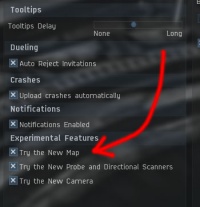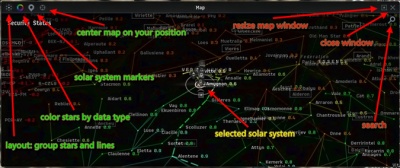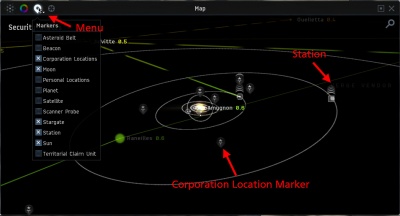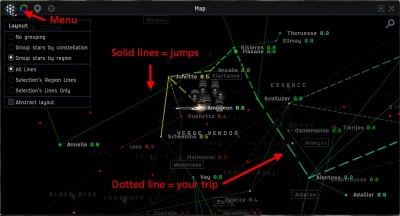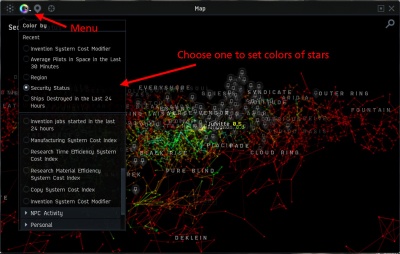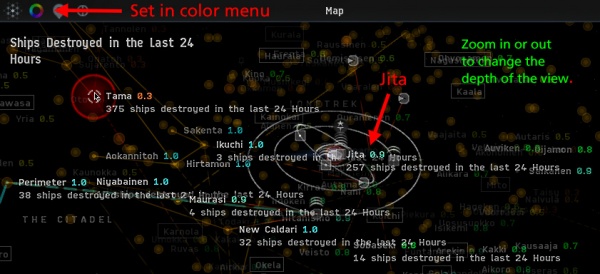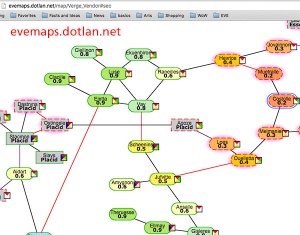Difference between revisions of "User:Qwer Stoneghost/Old user page"
| Line 86: | Line 86: | ||
{{clear}} | {{clear}} | ||
| − | + | == Using DOTLAN with the Map Beta == | |
[[File:Qs dotalnvv.jpg|thumb|left|300px|alt=evemaps.dotlan.net]] | [[File:Qs dotalnvv.jpg|thumb|left|300px|alt=evemaps.dotlan.net]] | ||
Revision as of 20:29, 15 February 2016
Map (Beta) While the Star Map is still the standard tool for finding your way through the universe, EVE has been testing a new map that they call "Map Beta". This page describes the features of the new map and shows how to access them.
Getting to the New Map Beta
To use Map Beta you first have to tell the game that you want to access it. You do this in the game settings window, which you can open by pressing the ESC key.
Click on the "General Settings" tab, and then go down to the "Experimental Features" section. Check the box for "Try the New Map", and it will appear in your neocon under the name "Map Beta"
Next, go to the "Shortcuts" tab and then to the "Windows" tab in the shortcuts. There you will be able to set a hot key for "Map Beta".
The new and old maps are entirely separate. They do not interfere with one another, and you can have both of them open at once if you want to. (Note that Map and Map Beta are both full blown maps and so are different from the "Map Browser", which is a kind of mini-map.)
Map Beta Overview
Map Beta is three-dimensional. Stars are shown as colored dots - the shades of which can be changed to represent different sorts of data: security status, services, sovereignity, number of pilots in space, and many others. Lines show the jump gate connections between stars, with the path from your current location to the selected system shown as dotted.
Rolling your mouse's scrollbar will zoom the map in and out. Drag on the map to rotate its orientation. Click on a star to center it in the window. (Note that you cannot drag the map sideways or up and down. To move the map that way you have to click on a star - when the star comes to the center, the map will move in that direction.)
When you open the map, it will be centered on a Selected System. This is most often the system where you are currently located. You can use your mouse wheel to zoom in until you see the system in great detail ... planets, moons, stations, asteroid belts, etc. Or, you can zoom out until you see the entire universe.
Three buttons at the top right of the map control window activities.
- Clicking on the X will Close the Map Beta window.
- Clicking on the magnifying glass icon will open the Search box. As you begin to type in the box, the search will give you a list of matching star systems. Click on a star name to focus the map on that system and draw a dotted line to there from your current position. If you click on a moon or other object, that object will be focused in the center of the map, and the map will zoom in to show the star system in detail.)
- Clicking on the little square with the dot in the middle will open the Resize option box. Here you set the map window to full screen mode, dock it to either side of your screen, or tell it to float in the middle of your screen. The docked windows can be resized left or right ... the floating window can be resized in any direction.
Four buttons at the top left of the map control formatting.
- The rightmost "Focus" button will always center the map on your position.
- The leftmost Layout button opens a menu that lets you change the display of star groups and jump lines. You can group systems by region or constellation, or you can have no grouping. Similarly, you can show all jump gate lines, all the ones in the region you are looking at, or just the ones connected to the star you have selected. At the bottom of this menu is a box labeled "Abstract Layout." Checking this box collapses the map into a flat, more 2-dimensional view.
- The second, Color button opens an extensive menu of data items. Clicking on an item tells the map to color the stars according to that kind of data. "Security Status", for example, shows the typical green, yellow and red colors of the various levels. Some data types produce fuzzy balls around some systems - "Ships Destroyed in the Last 24 Hours" for example, puts a sphere around each star ... bigger for greater totals of killed ships.
- The third, greyish button opens a menu that lets you show or hide Solar System Markers. These show icons for such as planets, stations, locations, and asteroid belts. Markers are only visible when you are zoomed in for a closeup view of a system.
Using the Map Beta Controls
The solar system menu lets you fine tune what you see in around a star. If you are mining, for example, you can show asteroid belts and omit moons and planets. If you are scouting, you can show corporate and personal locations. And if you are exploring, you can see scanner probes.
Clicking on an icon will bring up the usual menu showing "show info", "set destination", "set waypoint", and so on. You cannot act on these ... for example, you cannot click on a location and warp to it, or jump through a gate.
The layout menu let's you set the way that star systems will be grouped on the map period. And it also let's you decide which jump blinds will be shown.
The no groping option is the most expensive. It shows the largest number of individual stars. Grouping stars by region for constellation klumps them together and organizes the map to keep them distinct. This is most useful when you are looking at longer distances, and least useful when you are trying to plot a course from one star to another.
The three lines selection options determine which lines will light up when you move the mouse over a star system.
The color menu is arguably the most useful. It allows you to color the star systems based on categories such as region, race, security, and star color, as well as on various kinds of data that the game has collected.
For example, here are a few of the options:
- Services
- Repair Facility
- Clone Bay
- Industry
- Manufacturing Systems Cost Index
- Personal
- My Assets
- My Cargo Illegality
The menu keeps your last few most recent selections at the top of the list for easy reference.

